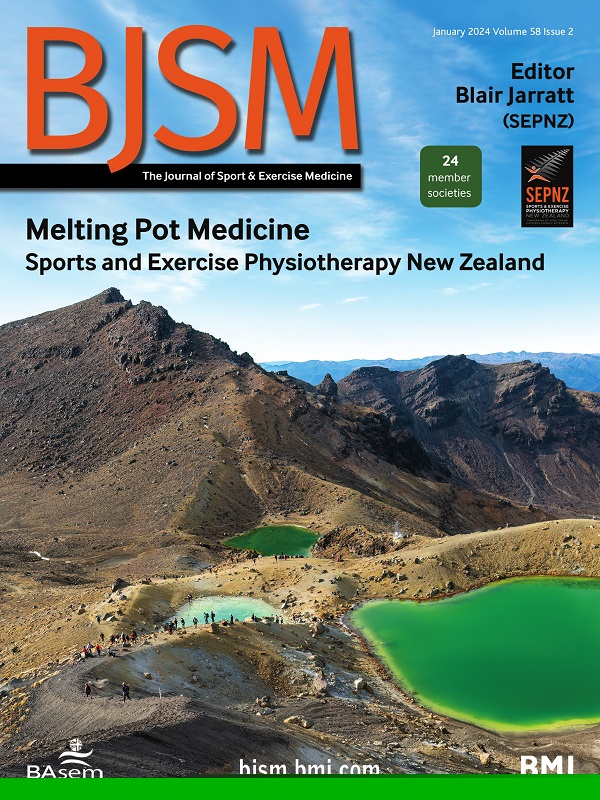Systematic video analysis of 57 hamstring injuries in women’s football (soccer): injury mechanisms, situational patterns and biomechanics
IF 16.2
1区 医学
Q1 SPORT SCIENCES
引用次数: 0
Abstract
Objective To investigate the occurrence and inciting events of hamstring injuries (HSIs) in elite women’s football through video analysis, describing the mechanism, situational patterns and biomechanics of the sport-specific activities performed before and at the time of injury. Methods A descriptive observational study was conducted using video analysis of HSIs from top national and international women’s football competitions across seven seasons (2017/2018 to 2023/2024). Three raters independently categorised HSIs following the Football Injury Inciting Circumstances Classification System and analysed joint and trunk kinematics. Results Among 109 identified HSIs, 57 (52%) were eligible for analysis. Most injuries (74%) were non-contact, with 51% occurring during running and 49% during stretch-type movements, including kicking and duelling. These patterns involved ball interaction in 68% and duels in 51% of cases. Injuries predominantly occurred in offensive situations (72%), with moderate to high horizontal speed and minimal vertical movement. Biomechanical analysis indicated frequent knee extension and hip flexion. Conclusion HSIs in women’s football predominantly occur during movements with high eccentric demand of the hamstring muscles, with non-contact mechanisms being most common. HSIs are not solely linked to high-speed running but can also occur during propulsion and braking phases, or overstretching activities with an open or closed kinetic chain. HSIs often resulted from complex movements involving multiple tasks simultaneously under high physical and mental demands, in unpredictable and evolving scenarios. Data are available upon reasonable request.57例女足腿筋损伤的系统视频分析:损伤机制、情境模式和生物力学
目的通过视频分析,探讨优秀女足运动员腿筋损伤(hsi)的发生及诱发事件,描述伤前及伤时专项运动的机制、情境模式及生物力学。方法采用描述性观察研究方法,对2017/2018 - 2023/2024七个赛季国内外顶级女足比赛的hsi进行视频分析。三位评分员根据足球伤害煽动情况分类系统对hsi进行了独立分类,并分析了关节和躯干的运动学。结果109例hsi中,57例(52%)符合分析条件。大多数伤害(74%)是非接触性的,51%发生在跑步过程中,49%发生在伸展式运动中,包括踢腿和决斗。这些模式包括68%的球相互作用和51%的决斗。受伤主要发生在进攻情况下(72%),有中高水平速度和最小的垂直运动。生物力学分析显示频繁的膝关节伸展和髋关节屈曲。结论女子足球hsi主要发生在腿筋高偏心需求运动中,非接触机制最为常见。hsi不仅与高速运行有关,还可能发生在推进和制动阶段,或者在打开或关闭动力链的过度拉伸活动中。hsi通常是在不可预测和不断变化的情况下,在高体力和精神要求下同时涉及多个任务的复杂运动。如有合理要求,可提供资料。
本文章由计算机程序翻译,如有差异,请以英文原文为准。
求助全文
约1分钟内获得全文
求助全文
来源期刊
CiteScore
27.10
自引率
4.90%
发文量
217
审稿时长
3-8 weeks
期刊介绍:
The British Journal of Sports Medicine (BJSM) is a dynamic platform that presents groundbreaking research, thought-provoking reviews, and meaningful discussions on sport and exercise medicine. Our focus encompasses various clinically-relevant aspects such as physiotherapy, physical therapy, and rehabilitation. With an aim to foster innovation, education, and knowledge translation, we strive to bridge the gap between research and practical implementation in the field. Our multi-media approach, including web, print, video, and audio resources, along with our active presence on social media, connects a global community of healthcare professionals dedicated to treating active individuals.

 求助内容:
求助内容: 应助结果提醒方式:
应助结果提醒方式:


